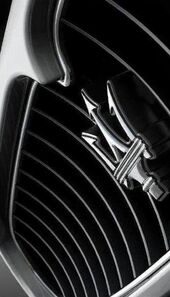
| |
| Maserati Ghibli | |
|---|---|
| Maserati | |
| aka | Tipo AM.115 / Ghibli I |
| Production | 1967-1973 |
| Class | Grand Tourer |
| Body Style | 2+2-seat coupé, 2-seat spyder |
| Length | 180.7 in (4589 mm) |
| Width | 70.8 in (1798 mm) |
| Height | 56.6 in (1437 mm) |
| Wheelbase | 100.39 in (2550 mm) |
| Weight | 2645.5 lb (1200 kg) |
| Transmission | ZF 5-speed manual, RWD |
| Engine | 4.7 litre (4719 cc) 90º V8, Four twin-choke 40 DCNL/5 Weber carburettors 4.9 litre (4930 cc) 90º V8, Four twin-choke 40 DCNL/5 Weber carburettors |
| Power | 330 hp @ 5000 rpm, 290 lb-ft @ 4000 rpm 335 hp @ 5500 rpm, 330 lb-ft @ 4000 rpm |
| Similar | Ferrari Daytona Lamborghini Miura De Tomaso Mangusta |
| Designer | Giorgetto Giugiaro under Ghia |
The Maserati Ghibli is a two-door, two-seater coupe released by Maserati in 1967. The V8-powered Ghibli was the most popular Maserati vehicle since the automaker withdrew from racing in the 1950s, and it outsold its two biggest rivals, the Ferrari Daytona and the Lamborghini Miura. It debuted at the 1966 Turin Motor Show.
The Ghibli's steel body, renowned for its low, shark-shaped nose, was designed by Giorgetto Giugiaro. Giugiaro, who today heads his own company ItalDesign, worked at coachbuilder Ghia when he designed the Ghibli.
The car was powered by a front-placed quad-cam 330hp V8 engine. It had a 0-60 mph acceleration time of 6.8 seconds, had a top speed of 154 mph and could be operated by either a five-speed manual or three-speed automatic transmission. Maserati fitted the car with two fuel tanks, which could be filled via flaps on either side of the roof pillars. The car also featured pop-up headlamps, leather sport seats and alloy wheels.
The convertible Ghibli Spyder went into production in 1969. The Spyders were relatively rare, and the coupes outnumbered them almost ten to one. The slightly more powerful Ghibli SS (335 hp) was released in 1970. The Ghibli went out of production in 1973 and found a successor the following year with the Bertone-designed Khamsin.
External links[]
